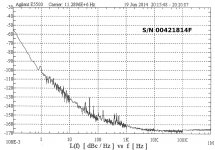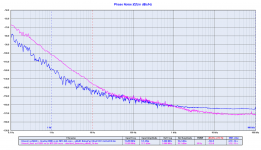FifoPi Q3
FifoPi Q3 new improvements
· Supports XOs with and without an OE pin
· Uses pure 3.3V for clean side DC power input. All LDOs at the clean side had been removed to make it possible to work with a better 3.3V LifePO4 or ultra capacitor power supply solution directly.
· With optional u.fl XO input sockets to work with external XOs through coaxial cables.
· Supports single XO mode
· SMT XO sockets, easy to replace and remove.
· With both isolated MUTE and isolated DSD EN outputs to work better with pure DSD DACs or external PCM/DSD DACs (through TransportPi or HdmiPi).
· New 300MHz high speed flip-flops to lower the additive jitter of I2S/DSD re-clocking at finial output stage.
· Optimized decoupling networks to improve power supply performance.
FifoPi Q3

FifoPiQ3_2 by Ian, on Flickr
FifoPiQ3 works with Pulsar OCXOs (without OE control pin)

FifoPiQ3_OCXO by Ian, on Flickr
Ian
FifoPi Q3

FifoPiQ3_2 by Ian, on Flickr
FifoPiQ3 works with Pulsar OCXOs (without OE control pin)

FifoPiQ3_OCXO by Ian, on Flickr
Ian
Pulsar OCXOs look sweet. Wish I discovered this site a few years back.
Just discovering there's a Pulsar Clock thread last week:
Pulsar Clock - Ultra Low Noise OCXO
At least I get to keep a kidney since these are unavailable.
Just discovering there's a Pulsar Clock thread last week:
Pulsar Clock - Ultra Low Noise OCXO
At least I get to keep a kidney since these are unavailable.
Pulsar OCXOs look sweet. Wish I discovered this site a few years back.
Just discovering there's a Pulsar Clock thread last week:
Pulsar Clock - Ultra Low Noise OCXO
At least I get to keep a kidney since these are unavailable.
My OCXO module, including the power supply module, is being tested and modified at the end. If the sound is really good and not lose to Pulsar, I will launch a group buy.
If you want to improve the Raspberry Pi's noise problem, in fact, the improvement method is not from an external power supply, nor is it to buy StationPi, but to remove the very bad built-in DC-DC power supply of the Raspberry Pi, and then supply power separately from the outside PP5: GND, PP7 : 5V, PP8: 3.3V and pp9: 1.8V. That is, first remove the built-in DC-DC power supply of the Raspberry Pi in the photo. For details, please refer to the Raspberry Pi manual.
Schematics - Raspberry Pi Documentation
View attachment 875858
View attachment 875859
View attachment 875860
You describe it perfectly what is the problem with the Raspberry power supply, and I wonder if anyone has done what you detailed, inputting new precision regulators into each PP.
Is anyone doing that in this thread, or has done it, or they just isolate the power pins galvanically from other stages, so you can power them separately?
I have heard of a new Pi power supply that apparently iancanada had developed or was developing, supposedly correcting that Raspberry weak design area, which I don't know if it's true.
Last edited:
FifoPi Q3 Ultimate Manual uploaded:
DocumentDownload/FifoPi at master * iancanada/DocumentDownload * GitHub
Still drooling over Pulsar clocks...
DocumentDownload/FifoPi at master * iancanada/DocumentDownload * GitHub
Still drooling over Pulsar clocks...
Last edited:
You describe it perfectly what is the problem with the Raspberry power supply, and I wonder if anyone has done what you detailed, inputting new precision regulators into each PP.
Is anyone doing that in this thread, or has done it, or they just isolate the power pins galvanically from other stages, so you can power them separately?
I have heard of a new Pi power supply that apparently iancanada had developed or was developing, supposedly correcting that Raspberry weak design area, which I don't know if it's true.
You may want to have a peek at this multiple choice voltage solution for RPi:
Mezzanine Power board<br>for Raspberry Pi
It's been around for over one year and, I believe, it was discussed here on DIYAUDIO.COM
Still drooling over Pulsar clocks...
Are you sure? Please compare the following plots:
- the Driscoll oscillator at 11.2896 MHz is around 6 dB better than the Pulsar at the same frequency (pink line)
- the Driscoll oscillator at 5.6448 MHz with doubler is around 20 dB better than the Pulsar at the same frequency (blue line)
Attachments
Looking at the real crystal osc. data:
Pulsar. MORI
1Hz. - 101. - 102
10Hz - 132. - 136
100Hz. - 155 - 152
1kHz. - 161 - 161
I think it's a real achievement, from a russian tech company, in ~1. 5cm^3. (Pulsar was just rebadging..)
Pulsar. MORI
1Hz. - 101. - 102
10Hz - 132. - 136
100Hz. - 155 - 152
1kHz. - 161 - 161
I think it's a real achievement, from a russian tech company, in ~1. 5cm^3. (Pulsar was just rebadging..)
Last edited:
ooops... right, I forgot, the size of the oscillator is crucial to stack all the devices.
I'm from the old school, outdistance and shield.
I'm from the old school, outdistance and shield.
ian,
when will the fifopi Q3 be available?
thanks
Now.
IAN CANADA FIFOPI Q3 ULTIMATE FIFO Reclocker Module PCM 32bit 768kHz DSD1024 DoP - Audiophonics
Hm.. Size of an oscillator means it can be placed 20mm from the point of delivery (the Dac chip). On the same ground plane, with dedicated local regulation.
I don't know better solution?
Apart from this, You are doing a real great work, no need of extra publicitary support, me thinks..
I don't know better solution?
Apart from this, You are doing a real great work, no need of extra publicitary support, me thinks..
Looking at the real crystal osc. data:
Pulsar. MORI
1Hz. - 101. - 102
10Hz - 132. - 136
100Hz. - 155 - 152
1kHz. - 161 - 161
I think it's a real achievement, from a russian tech company, in ~1. 5cm^3. (Pulsar was just rebadging..)
Most of the Pulsar phase noise plots I have seen were better than the claimed
specs. I think Morion (Russian) are better again but you have to pay for it.
TCD
Hm.. Size of an oscillator means it can be placed 20mm from the point of delivery (the Dac chip). On the same ground plane, with dedicated local regulation.
I don't know better solution?
Apart from this, You are doing a real great work, no need of extra publicitary support, me thinks..
It looks like the oscillator is placed 5 mm from the FIFO not from the DAC.
Rather a couple of oscillators at different frequencies are placed in the same place at a distance of a few mm, IMHO they can interfere with each other.
And yes, I know a better solution and I believe TNT too (RF school). And also Terry.
You may want to have a peek at this multiple choice voltage solution for RPi:
Mezzanine Power board<br>for Raspberry Pi
It's been around for over one year and, I believe, it was discussed here on DIYAUDIO.COM
Thanks, Mike. Would love to find that discussion. Perhaps using "mezzanine" as search word I can find it.
Not sure I quite understand what the final price is. It's out of stock now.
A friend told me Iancanada had a similar Raspberry power supply replacement in the works, I think the name was Pi. Is that true?
If I understand it well, plugging this board in fact eliminates the Rasp on board supply: is that so?
Are you sure?
For my current situational keep in simple minimalistic needs, yes. The Pulsar Clocks are compact and somewhat plug and play. No external board and no 12V power supply.
If there was a compact plug and play TWTMC 5.6448 MHz requiring no external board and power that of course would be more optimal. But given my current project and the legendary Pulsar clock performance, it would be a dream to have Pulsar clocks.
For future projects, the main focus will be TWTMC 5.6448 MHz. But for now I have to work with minimalistic constraints.
@carlmart
ConditionerPi or LinearPi
Please find the my GitHub link below my signature.
Regards,
Ian
ConditionerPi or LinearPi
Please find the my GitHub link below my signature.
Regards,
Ian
Most of the Pulsar phase noise plots I have seen were better than the claimed
specs. I think Morion (Russian) are better again but you have to pay for it.
TCD
Interesting, will keep tabs on Morion.
Someone also posted Magic Xtal:
Magic Xtal Ltd. development and production of OCXO, crystal oscillator, crystal oscillators, oven control crystal oscillator (OCXO), oven control crystal oscillators (OCXOs), miniature OCXO, ultra-stable OCXO, low phase-noise OCXO, high stability OCXO, high frequency OCXO, vacuum-sealed miniature OCXO, vacuum-sealed OCXO, crystals, crystal, кварцевый генератор , опорный генератор, опорный кварцевый генератор, малошумящий генератор, термостатированный генератор, термостатированный кварцевый генератор, миниатюрный генератор, миниатюрный кварцевый генератор, миниатюрный термостатированный кварцевый генератор, кварцевый резонатор, низкий фазовый шум, Products
IanCanada's Latest RPi GB Goodies Impressions... and your tweaks, mods and hints...
But haven't read any comments if anyone has tried these items...
- Home
- Source & Line
- Digital Line Level
- Asynchronous I2S FIFO project, an ultimate weapon to fight the jitter

